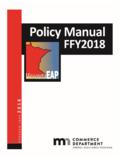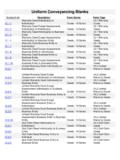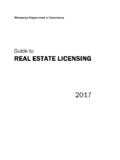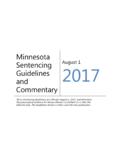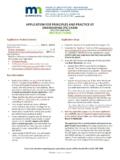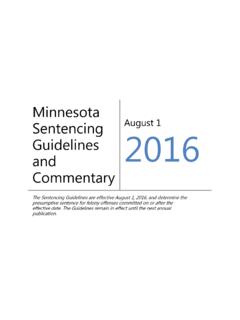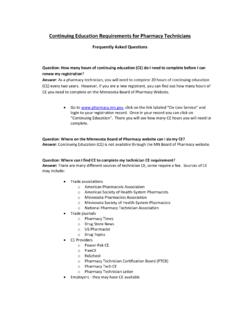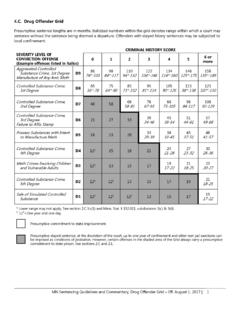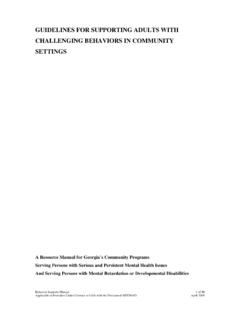Transcription of HR/LR Policy #1337 - Sick Leave
1 HR/LR Policy #1337 Issued 07/31/1997. Revised 04/24/2015. sick Leave Authority Labor Relations OVERVIEW. Objective To improve productivity, minimize cost, and maintain overall agency morale by standardizing review of employees' use of accrued sick Leave . Policy Statement Agencies will track and monitor employees' use of accrued sick Leave as permitted by law to ensure that use of accrued sick Leave is appropriate. Scope This Policy applies to employees of executive branch agencies and classified employees in the Office of Legislative Auditor, Minnesota State Retirement System, Public Employee Retirement System, and Teachers' Retirement System. Definitions Safety Leave is Leave for the purpose of providing or receiving assistance because of sexual assault (under or ), domestic abuse (under ), or stalking (under ).
2 Child includes a stepchild and a biological, adopted, and foster child. Grandchild includes a step-grandchild and a biological, adopted, and foster grandchild. Exclusions N/A. Statutory , References GENERAL STANDARDS AND EXPECTATIONS. I. SUPERVISOR RESPONSIBILITIES. a) Analyze attendance records. Supervisors will regularly review employee attendance records for evidence of abuse or excessive use of accrued sick Leave . b) Ensure appropriate use. Supervisors will ensure that the reason for the use of accrued sick Leave is allowable under the terms of the collective bargaining agreement, plan, or applicable law. State law permits employees to use their sick Leave for absences due to an illness or injury to the employee's child, adult child, spouse, sibling, parent, mother-in-law, father-in-law, grandchild, grandparent, or stepparent for reasonable periods of time as the employee's attendance may be necessary, on the same terms upon which the employee is able to use sick Leave benefits for the employee's own illness or injury.
3 Employees may also use their sick Leave for safety Leave for such reasonable periods of time as may be necessary for assistance to the employee or assistance to 1. GENERAL STANDARDS AND EXPECTATIONS. the relatives described above. An employee who is qualified to use sick Leave in this manner is defined in the law to mean a person who is employed for at least 12 months preceding the request for Leave , and who, during the 12-month period immediately preceding the Leave , worked an average number of hours per week equal to of the full-time equivalent position in the employee's job classification. Employers may limit the employee's use of his or her sick Leave for safety Leave or for absences due to an illness of or injury to the employee's adult child, spouse, sibling, parent, mother-in-law, father-in-law, grandchild, grandparent, or stepparent to 160 hours in a 12-month period.
4 Employers may not limit the employee's use of his or her sick Leave for absences due to the illness or injury of the employee's child under 18 years of age or under age 20 who is still attending secondary school. Employers may not retaliate against an employee for legitimately requesting or using sick Leave for safety Leave or for care of relatives as described above. c) Ensure confidentiality. Supervisors and human resources staff will maintain the confidentiality of the reasons for employees' use of sick Leave . d) Recognize good attendance. Supervisors will recognize good attendance through appropriate methods. e) Manage sick Leave . Supervisors will regularly monitor and manage all of the accrued sick Leave used by employees in accordance with this Policy . II. USE OF ACCRUED sick Leave WHERE NO ABUSE HAS OCCURRED.
5 A) Monitoring use of sick Leave . Supervisors are expected to monitor the amount of accrued sick Leave used by employees and to review sick Leave usage for individual employees when use exceeds six separate instances in a fixed 12-month period, as described below. The six events standard does not define excessive use, but rather the point at which the supervisor should begin to consider item (II)(b), below. Instances of sick Leave usage that count toward the six events triggering a review include: All actual sick Leave used for the employee's own illness or injury, as well as other types of Leave used in lieu of sick Leave for the employee's own illness or injury ( , same-day vacation Leave requested in lieu of sick Leave and Leave without pay taken for sick Leave reasons) except as described below.
6 Instances of sick Leave usage that will NOT count toward the six events triggering a review include legitimate use for the following: o any FMLA-qualifying time or time taken for prescheduled doctor's appointments, o bereavement Leave , o sick Leave for safety Leave by qualifying employees (as described above in Section I), o sick Leave for care of relatives (as described above in Section I), o workers compensation Leave , o Leave time given as a reasonable accommodation for a disability, o sick Leave used in conjunction with the birth or adoption of a child or for the period of time that a doctor certifies a female employee unable to work because of pregnancy, or o other leaves of absence to which the employee is entitled under statute. Supervisors will monitor the amount of accrued sick Leave used by employees for safety Leave or for 2.
7 GENERAL STANDARDS AND EXPECTATIONS. absences due to an illness of or injury to the employee's adult child, spouse, sibling, parent, mother-in-law, father-in-law, grandchild, grandparent, or stepparent to ensure that such use of sick Leave does not exceed 160 hours in a 12-month period. b) Recognizing sick Leave use problems. In considering whether use of accrued sick Leave is excessive, a supervisor will consider the following factors: The frequency of any pattern and the reasons for sick Leave use. The employee's unused sick Leave balance. The impact of the employee's absences on the workplace ( , disruptions in work schedules, overtime costs, incomplete projects). The employee's sick Leave accrual date. c) Responding to sick Leave problems. If the supervisor determines that an employee's use of accrued sick Leave has been excessive, then the supervisor will: Counsel the employee on his/her use of sick Leave .
8 Refer the employee to the Employee Assistance Program, if appropriate. Check with the agency's human resources office about possible alternative arrangements for the employee ( , part-time work schedules, disability leaves of absence or accommodation) if appropriate. If the employee's excessive sick Leave use continues, a supervisor should consider the effect that the sick Leave use has on the employee's performance and the operations of the employer. Discipline may be taken on the basis of the absences affecting the employee's performance or the operations of the employer, and may be taken even when the reasons for sick Leave use have been legitimate. Disciplinary action must NOT be taken for legitimate use of accrued sick Leave for: o absences related to FMLA-qualifying time, o prescheduled doctor's appointments, o bereavement Leave , o sick Leave for safety Leave (as described above in Section I), o sick Leave for care of relatives (as described above in Section I), o workers compensation Leave , o Leave time given as a reasonable accommodation for a disability, o sick Leave used in conjunction with the birth or adoption of a child or for the period of time that a doctor certifies a female employee unable to work because of pregnancy, or o other leaves of absence to which the employee is entitled under statute.
9 If the employer is in the course of progressive discipline with an employee, the six instance standard in a 12-month period is not renewed. d) Performance reviews. The employee's performance review should reflect how the employee's attendance has affected his/her ability to complete job tasks. Supervisors should NOT take into account for performance review purposes legitimate use of 3. GENERAL STANDARDS AND EXPECTATIONS. accrued sick Leave for: o FMLA-qualifying time, o prescheduled doctor's appointments, o bereavement Leave , o sick Leave for safety Leave (as described above in Section I), o sick Leave for care of relatives (as described above in Section I), o workers compensation Leave , o Leave time given as a reasonable accommodation for a disability, o sick Leave used in conjunction with the birth or adoption of a child or for the period of time that a doctor certifies a female employee unable to work because of pregnancy, or o other leaves of absence to which the employee is entitled under statute.
10 III. sick Leave ABUSE. Abuse of sick Leave is defined as the use of sick Leave for purposes other than those provided by collective bargaining agreements, plans, or as allowed by statute. Supervisors should periodically analyze attendance records for evidence of possible abuse ( , patterns of absences on Fridays/Mondays, seasonal absences, absences when a vacation request has been denied). sick Leave should be denied when there is evidence or reason to believe abuse has occurred, until or unless the employee provides satisfactory evidence of legitimate use of sick Leave . Where a supervisor has reason to suspect that an employee is abusing sick Leave , the supervisor may require the employee to provide documentation to verify or corroborate legitimate use of sick Leave .
